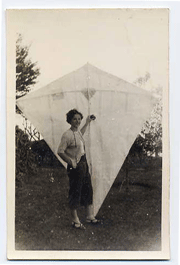Entries in Historical Research - Kites (4)
First Kite History Symposium Held In Burlington, Ontario.
On February 6, 2010 a group of interested kite enthusiasts gathered at Discovery Landing, on the Lake Ontario shoreline in Burlington, Ontario, to immerse themselves in day dedicated to the exploration of kite history. This was the first ever Kite History Symposium held in eastern North America.
The event was sponsored and organized by the Canadian Kite Museum under the direction of George Paisiovich, Museum Founder and Director.

The program for the day featured:
- a two hour informal morning gathering of the registered kiters examining historic kite artefacts, photographs and print materials;
- a welcome to the Kite History Symposium by George Paisiovich in which he outlined his goal of providing a periodic forum for the discussion and advancement of knowledge of kite history;
- a one hour presentation by Bob White of Port Colborne, ON about the kites of Dr. Alexander Graham Bell. This preliminary report on research in progress brought participants up to date on the work being done to carefully detail the step by step progress made by Dr. Bell on his path to understand the principles of flight and to get a person into the air.
- a presentation by Meg Albers of Buffalo, NY on the kite exploits of Homan Walsh whose kite helped to build a bridge across the Niagara River in 1848. Meg also revealed some documents she has received that prove the use of kites during the American Civil War. She continues her research into kites in the Civil War era.
- a two hour presentation by Thom Shanken of Waterloo, NY about his research into the world's oldest kite currently located at the Drachen Foundation in Seattle, WA. Thom Shanken, an expert in 16th century kites, was invited by the Drachen Foundation to examine the kite and make a detailed analysis of this amazing historical find. Thom presented slides and an interesting description of his work with the kite. Following this, a replica of the kite was constructed by the participants. The replica is detailed in the slide show below. The replica is now part of the collection of the Canadian Kite History Museum.

At the end of the day, the participants gathered for an informal evening meal and conversation about the events of the day.
A terrific slide show of the Kite History Symposium was prepared by Ted Shaw of the Great Lakes Kitefliers in Western New York state. My appreciation is extended to Ted for allowing me to share his photos of the event here.
The next Kite History Symposium sponsored by the Canadian Kite Museum will be held in October 2010. As details are announced I will provide a link to the information here.
Appreciation is extended to George Paisiovich for his outstanding work in support of the preservation of kite history and efforts to foster and disseminate knowledge of current kite history research work that is underway.
Addition of Kite History Fact of the Day
 Although it has been a few months since my last post to the Best-Breezes blog section of this web site, a lot has been going on behind the scenes.
Although it has been a few months since my last post to the Best-Breezes blog section of this web site, a lot has been going on behind the scenes.
Extensive work has been done to improve the Time Lines of Kite History and updated versions of these much visited resources on the site should be posted by the end of May. Numerous typographical corrections have been made to make the information much more accurate. In addition, new events have been added to the timelines as the verification process for them ensured that they could be entered into the chronicle.
One interesting off shoot of this work has been the inclusion of a new page on the site entitled Kite History FACT OF THE DAY.
Using some of the facts in the Time Lines of Kite History data base, a JavaScript has been added to display a new fact each time visitors access this part of the site. It is hoped that these interesting facts will capture your imagination and help to enhance your experience on this web site.
Other detailed research has been going on in these past months on the following topics:
- kite pioneer Silas J. Conyne of Chicago, Illinois
- kite pioneer Major B.F.S. Baden-Powell of Great Britain
- the principles of kite flight (some of the research gathered on this topic will improve the section on The Science of Kite Flight)
- building a data base of old and historic kite photos that will be displayed in a random fashion of the home page of the web site.
The Time it Took! A Timeline of Kite History
 Time, it has been said, marches resolutely on and leaves a record of what has gone before if we are careful to observe.
Time, it has been said, marches resolutely on and leaves a record of what has gone before if we are careful to observe.
There are so many historical events over the course of time. The most recent events and happenings are well recorded and documented but can still be open to varying interpretation. The more distant events are harder to trace and often do not have many validating or corroborating sources of information. So it is with the history of the earth, of mankind, of cultures and nations, and of devices and inventions.
Several years ago, sixteen to be exact, I set out to puzzle out for myself a credible timeline of kite history. The purpose in my mind was simple: order the events and chronicle the people who had contributed to the development of the kite and used it in innovative and interesting ways. A simple task, I was sure.
Not so! Here I am sixteen years later publishing for the first time my efforts at recording a brief, and hopefully useful, chronology of the kite. I have postponed the publication of any of the timelines on this web site many times. I did this because I continued to find conflicting evidence about the order and timing of events. Revision, checking more sources, update and more revision became an ongoing state of affairs.
I believe that the timelines published here today are very accurate, but they are not infallible. As with any historical effort covering a broad scope there is room for error even with the most thorough checking of facts having been carried out.
I know that these timelines will need to be revised again and again as new information is brought forward and as conflicting evidence challenges details or dates.
I have published the timelines at this juncture because I believe in their accuracy. I know that the scrutiny of kiters and people with a deep interest in things historical will undoubtedly lead to challenges and the correction of possible errors. I welcome your input, your questions, your dialogue and your sharing of factual evidence. Only through such cooperative effort can a properly validated timeline of kite history be available for use by students in schools and for reference by kiters who would like to know more about the development of this amazing device, the kite.
To begin your journey through time and experience the chronicle of the kite, I invite you to visit the Best-Breezes Timeline of Kite History.
Please contact me if you wish more information, have questions or can suggest some sources or evidence to improve the timeline.
Bob White - Hifliercanada - October 30, 2006
_______________________________________
Captain Jean-Luc Picard:
"Time is a companion that goes with us on a journey. It reminds us to cherish each moment, because it will never come again. What we leave behind is not as important as how we have lived."
played by Patrick Stewart, from the film "Star Trek: Generations"
An Interesting Theory on Man Lifting Kites in Pre-History
While doing some research deep in an on-line University archive, I came across a reference to a theory on an early use of kites to life humans that I had never seen before.
August Steinman has put forth a rather surprising hypothosis about the huge soil drawings located between the towns of Nasca and Palpa in Peru. Located about 400 miles south of Lima, these huge geollyphs have intrigued archeologists since they were discovered by Paul Kosok of Long Island University (NY) in 1939.
August Steinman's hypothesis is that these were take off and landing areas for man lifting kites of the Nazca civilization. Steinman has stated that he believes:
"The people of the Nazca civilisation were able to fly kites that could take off and land while being tied to a rope. And they could even land without being tied like a glider. In spite of their Stone Age civilisation the Nasca had the technical prerequisites for the production of such kites through the manufacture of threads and fabric. That is known from many grave finds. The known two thousand years old history of manned kites in Asia also supports this possibility."
In addition to the account detailed in the university archives, Steinman gives a detailed account on the web site of the respected Otto Lillenthal Museum located in Anklam, Germany. The specific account of Steinman's theory of evidence pointing to a possible use of kites for man lifting much earlier than many believed possible in the Americas is well worth reading and pondering about.
Certainly, this will be cause for me to do some more digging and discussing of this hypothesis in the months ahead.
There is always something "new' in historical research about kites! No wonder I find it so interesting.





